
|   |

|   |
 e-mail: sunilkothari1933@gmail.com Nalanda Dance Research Centre's Nartanotsava Photos: Paresh Desai December 29, 2018 Established in 1966 by dancer, choreographer, researcher and Guru Dr Kanak Rele, Nalanda Dance Research Centre in Mumbai is a major research institution that has set high standards in academia winning national and international reputation. 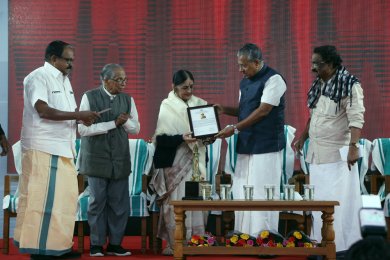 Kanak Rele receiving Guru Gopinath Nritya Puraskaram  Kanak Rele receiving Aditya Vikram Birla Kalashikhar Puraskar The two day dance festival of NDRC's Nartanotsava (November 24,25) held at Nalanda Nritya Kala Mahavidyalaya premises, at the auditorium Kanak Sabha, was noteworthy for two major reasons: Dr Kanak Rele wanted to honour not only her own senior disciples and colleagues with Nalanda Kanak Nartana Pursakar, but also to present senior local dancers who have dedicated their lives to dance and who willingly agreed to her mentorship to work and choreograph in their chosen dance form, themes selected by Kanak Rele with guidance on how they can extend the boundaries of the dance forms. Also this was a fortuitous occasion as Kanak Rele was honoured with Kerala Government's Guru Gopinath Nritya Puraskaram for 2018 for her significant contribution to Kathakali and Mohiniattam, and Mumbai based Aditya Vikram Birla Kalashikhar Puraskar 2018. On the opening evening as a part of the festival, Kanak, her disciple and daughter-in-law Dr. Uma Rele and granddaughter Vaidehi Rele Lal, presented choice items under title Rele's Nartana Parampara. Vaidehi trained in Bharatanatyam at Nalanda Nritya Kala Mahavidyalaya, the college affiliated to Bombay University, and under guidance of her mother Uma and grandmother Kanak, presented Simhavahini Varnam in Ranjani raga. The benign and ferocious aspects of the goddess were projected in traditional manner focusing on the divine nature of the goddess. The sanchari dwelt upon combat between Mahishasura and the goddess. She vanquishes the demon and is praised and addressed as Mahishasuramardini. The iconic image of the goddess attacking with trident was created with effect. Both in nritta and abhinaya, Vaidehi displayed her sound training. Uma Rele chose padam "Idendu vachitivira" giving a twist using ashta rasa when the truant lover turns up at the door, sarcastically asking him how he has come there on full moon night, perhaps missing his destination. It was an exercise in displaying her command over abhinaya that Uma showed various bhavas in interesting manner. She is now the Principal of Nalanda Nritya Kala Mahavidyalaya and has been teaching a number of students. The dancer creates bhavas, and they are experienced as rasas by the spectators. Selecting the shlokas for ashta rasas as mentioned in Bharata's Natyasastra, describing the various causes which create the emotions, how they are further delineated to generate rasa in the audience, Kanak enacted abhinaya in an engaging manner, each emotion from shringara to bibhatsa performed succinctly. Having studied Kathakali from childhood from asan Karunakaran Panicker, Kanak has undergone a thorough training in mukhajabhinaya. She kept the audience in thrall with her eloquent abhinaya. 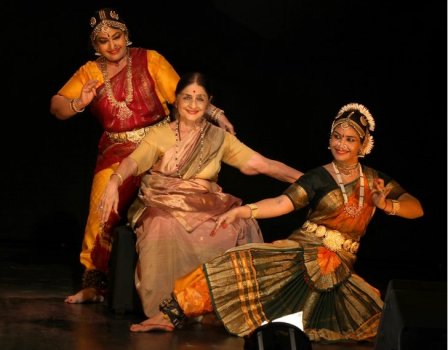 Uma Rele, Kanak Rele, Vaidehi Rele 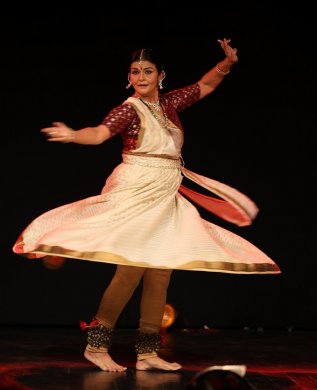 Shila Mehta Shila Mehta presented Nimitta, story of Shikhandi in Kathak.The issue of third gender has drawn attention in recent years. The third gender community has suffered a lot but of late, this community has come into its own and asserted its rights. It is accepted that soul is above gender and therefore they need not be despised. So far such a theme has not been attempted in Kathak. The story of Amba, Ambalika and Bhishma from Mahabharata is well known. Last year Shila had spent a month in Mumbai learning the story under Kanak Rele to grasp its implications, how to incorporate several elements into Kathak format and finally choreographed it as a solo Kathak. The title Nimitta was chosen as refusal of Amba by Bhishma resulted in revenge and became the cause, Nimitta, for Bhishma's death. Shila developed the theme taking assistance from her musicians and also Charani ballad singer for the text to use in the production. That worked well for choreography, as earlier also Shila had employed Charani ballad singing and text for her other Kathak productions. It suited perfectly as it describes war and how the fight between Arjuna and Bhishma results in shower of arrows on either side. The narration in Hindi establishes the context of war; the Charni singing describing the shooting of arrows makes one almost feel that the war is on. Bam bam, Rudra banam, banam sasi sit maha banam, megh banam, zala mangala, pavanam, jala banam, bija banam, Vajra banam enumerating various types of arrows in its nature of ferocity like Rudra, invoking rain, wind, water and thunderbolt, the war is on, the sky is all aflame and resounds, fight, fight, and with such recitation on both sides the arrows are let loose. In the current presentation, Shila used the costume normally worn by dancers in Kathak and performed in ekaharya lasyanga mode. As the story unfolds Arjuna moves his chariot towards the army of Kauravas, and saw before him Bhishma standing addressing Shikhandi to tell Arjuna that he can shoot as many arrows as he wants to, Bhishma shall never attack a woman. The unbearable pain in chest of Shikhandi turns into flashback. As Amba, the princess, she has all the grace in the world, her ornaments, garments, anklets, bangles, enhance her feminine beauty. Using the ghunghat ke gat, husna ki gat, bindi ki gat, and walking gracefully as Amba, Shila evoked her royal demeanor. The characteristic gat bhava and gat nikas of Kathak were used artistically. With garland, Amba proceeds to her beloved Salva, who rejects her and taunts her that she has been with Bhishma, and he would not marry her. A tearful Amba with folded hands begs of Bhishma to accept her, but he as a celibate does not relent. 'In what a state I am', cries Amba. She entreats him: 'Araj hai mori, karo na jora jori, Salva ko pati rupa me dekha, mai kaise naya byaha rachau?' (I have seen Salva as my husband, and now how can I have again another marriage? O Bhishma, put sindur on my head.) But Bhishma is steadfast in his decision. At this injustice, Amba wows to fight him in battle taking the birth as Shikhandi. Bhishma announces that he will not attack a woman, Shikhandi laughs at that and tells him that she is of third gender and asks Arjuna to kill Bhishma. The cry of Shikhandi tears the sky. As napunsaka, neither woman nor man, Shikhandi laments that she/he is Nimitta, a mere cause for the death of Bhishma, and prays to Lord Shiva that ultimately only he will rescue her when she goes unto him. As a solo it has been powerfully choreographed and in both phases of Amba and Shikhandi, Shila succeeds in portraying them distinctly. This time the presentation was tighter and with aharya in simple sari looked much better than the previous costume where Shila had worn a jacket and flared skirt to suggest half man, half woman. She just stood in abhanga with one arm in a relaxed pose to suggest feminine element. The collaborative attempt of a senior dancer like Kanak Rele and her guidance to much younger dancers augurs well. The Kathak dance form has been kept intact. The music, use of various talas in Kathak and overall impression of performance was praiseworthy. Jhelum Paranjape, disciple of Guru Kelucharan Mohapatra, is a distinguished Odissi exponent. She mentioned that when a senior dancer, choreographer and guru like 'Kanakben' invited her to work with her on a story from Mahabharata in Odissi, it was for her a blessing. Kanak's explanation of Sanskrit shlokas and text on Savitri and Satyavan helped Jhelum explore the Odissi form. She used the simple Odissi costume minus the elaborate head ornament. The music was as per Odissi parampara and sung tunefully. It was interesting to watch how Jhelum with her command over abhinaya brought alive characters of Savitri and Yamaraja. It was announced after Savitri's marriage with Satyavan that he would die soon. When time came to take his life away, Yamaraja arrived. Seeing her devotion to Satyavan, Yamaraja told her to ask for any boon except the life of her husband Satyavan. Savitri bowed to Yamaraja and asked for a life with a son after Satyavan's passing away. Yamaraja said 'Tathastu, so be it,' and Savitri smiled while bowing. It was then that Yamaraja realized that how can a widow have a son? And he allowed Satyavan to be with his devoted wife Savitri. Jhelum enacted the story with consummate artistry. As a devoted wife, looking after Satyavan, impersonating imperious Yamaraja with his noose, Yamapasha, Jhelum's abhinaya was impressive. 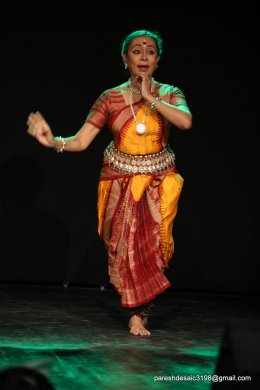 Jhelum Paranjape 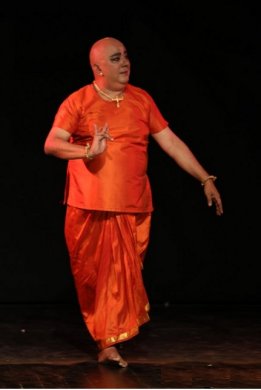 Deepak Mazumdar For Deepak Mazumdar, Kanak had selected from Valmiki's Ramayana, Sanskrit shlokas and also unknown kavi's muktakas, rich in imageries, similes and metaphors. Sensitive and poetic, they were gems of literature which made excellent content for abhinaya, beginning with Rama going to kill golden deer and finding it to be demon Maricha, Rama returns to see Lakshmana and they find that Sita has been kidnapped and both look for her in a state of complete distress. They go in search of Sita, they see desolate ashram, the yagna vedi is broken, fish lying on floor minus water, dried up flowers and leaves. Then they find the ornaments of Sita scattered on the floor. Here Kanak has selected the muktakas of four lines. Seeing necklace Rama is agonized. He laments: 'O Sita, I did not allow the necklace to be put on your neck as I could not bear the distance between us when I embraced you; I see this uttariya cloth, which during our love making I used to wipe the sweat; I used to spread it on the floor on which you used to sleep; I touch it and feel the touch of you, but alas you are not with me! Today, you and I are distanced by several rivers and mountains...' Then Rama and Lakshmana see a herd of deer and ask them Sita's whereabouts. The deer indicate the southern direction in which Sita was gone. These muktakas were enacted with deep intensity by Deepak epitomizing the anguish and the pain of separation suffered by Rama. Trained in Bharatanatyam by Kadirvelu Pillai and receiving theoretical knowledge of Natyasastra under Kanak, Deepak adopted the shlokas and text in Bharatanatyam in an interesting manner. Sunanda Nair now settled in Houston, USA, is the lead disciple of Kanak in Mohiniattam and her first student to get Ph.D in Mohiniattam under her guidance. With an amazing resemblance to Kanak, Sunanda has done her guru proud. Her Madhurashtakam had all the madhurya of Vallabhacharya's poem. Not only is the smile, the gait, the speech, the look of Krishna beautiful but also his various deeds. Sunanda enriched the presentation with sanchari of Krishna's bestowing wealth on his childhood friend Sudama when he visited him at Dwaraka. Sudama's surprise at the wealth of Dwaraka, its palatial mansions, and ambience overwhelmed him. When Krishna snatched away the rice Sudama had brought, Sudama was embarrassed. But Krishna took mouthfuls of it, reassuring Sudama that they tasted the best. When he returned home, Sudama did not find his old house, but a mansion, and his wife and children dressed in exquisite garments, all because of the benevolence of Lord Krishna. Sudama bowed to the divine lord whose madhurya, in terms of care, concern and love was unparalleled. Another choreographic work taught to her by Kanak was Kubja, based on Odiya poet Sitakant Mahapatra's poem and translated by Kavalam Narayana Panicker, set by him to Sopanam music. Sunanda brought to the fore, Kubja's desire to have glimpse of Lord Krishna and her agony and revulsion to anoint Kamsa with chandan paste. Finally Krishna turns her into a beautiful maiden, her hunch is removed (interpreted by Kanak as removal of burden of patriarchy) and she achieves bliss. Sunanda has a mobile visage that registers bhavas explicitly. Endowed with beauty, she indeed becomes Mohini in the form she practices and has perfected. 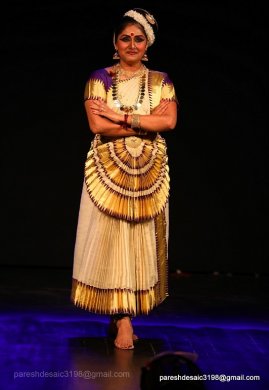 Sunanda Nair 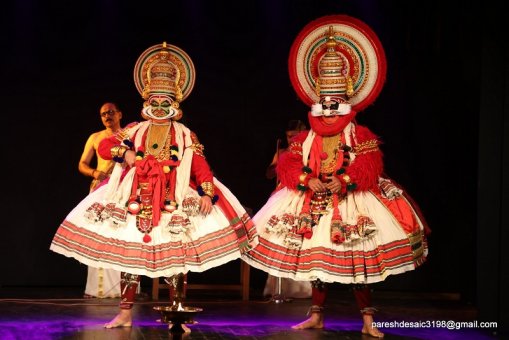 C. Gopalakrishnan & Kalakshetram Narayanan Guru C. Gopalakrishnan trained at Kerala Kalamandalam and has been a teaching faculty of Nalanda Nritya Kala Mahavidyalaya. In role of Raudra Bhima, he presented a sequence from Duryodhana Vadham with another dancer Kalakshetram Narayanan, in role of Dushasana in full glory of Kathakali make-up and costumes. The sequence was of Dushasana vadham. The musicians with chenda, maddalam, talam and singing transported the audience to Kerala, as both the artists and the musicians performed with such intensity that one forgot one was watching the play on a proscenium stage. Bhima while battling with Dushasan in Kathakali tradition takes role of Raudra Bhima and when he kills Dushasana, he tears open the stomach of Dushasana and takes out his entrails, besmears his palms with blood and strikes terror in the heart of the spectators. Lying on the floor, Dushasana tries to save himself but Raudra Bhima overpowers him. The theatre of cruelty as often described in the West, take shape before one's eyes. Both the actors struck terror among the children in the audience, so powerful was the presentation. The Nalanda Kanaka Nartana Puraskar awardees for 2017 are Dr. Uma Rele and Deepak Mazumdar for Bharatanatyam, Dr. Sunanda Nair for Mohiniattam. And for the year 2018 the awardees are Bharatanatyam dancer and vocalist Dr. Ambika Viswanath, Odissi dancer Jhelum Paranjape, Kathak dancer Shila Mehta. These exercises in mentoring senior artists by Kanak Rele have reaped rich dividends for artists and for the connoisseurs. The large turnout on both the days was indicative of the interest so generated.  Dr. Sunil Kothari is a dance historian, scholar, author and critic, Padma Shri awardee and fellow, Sangeet Natak Akademi. Dance Critics' Association, New York, has honoured him with Lifetime Achievement award. Post your comments Please provide your name and email id when you use the Anonymous profile in the blog to post a comment. All appropriate comments posted with name & email id in the blog will also be featured in the site. |